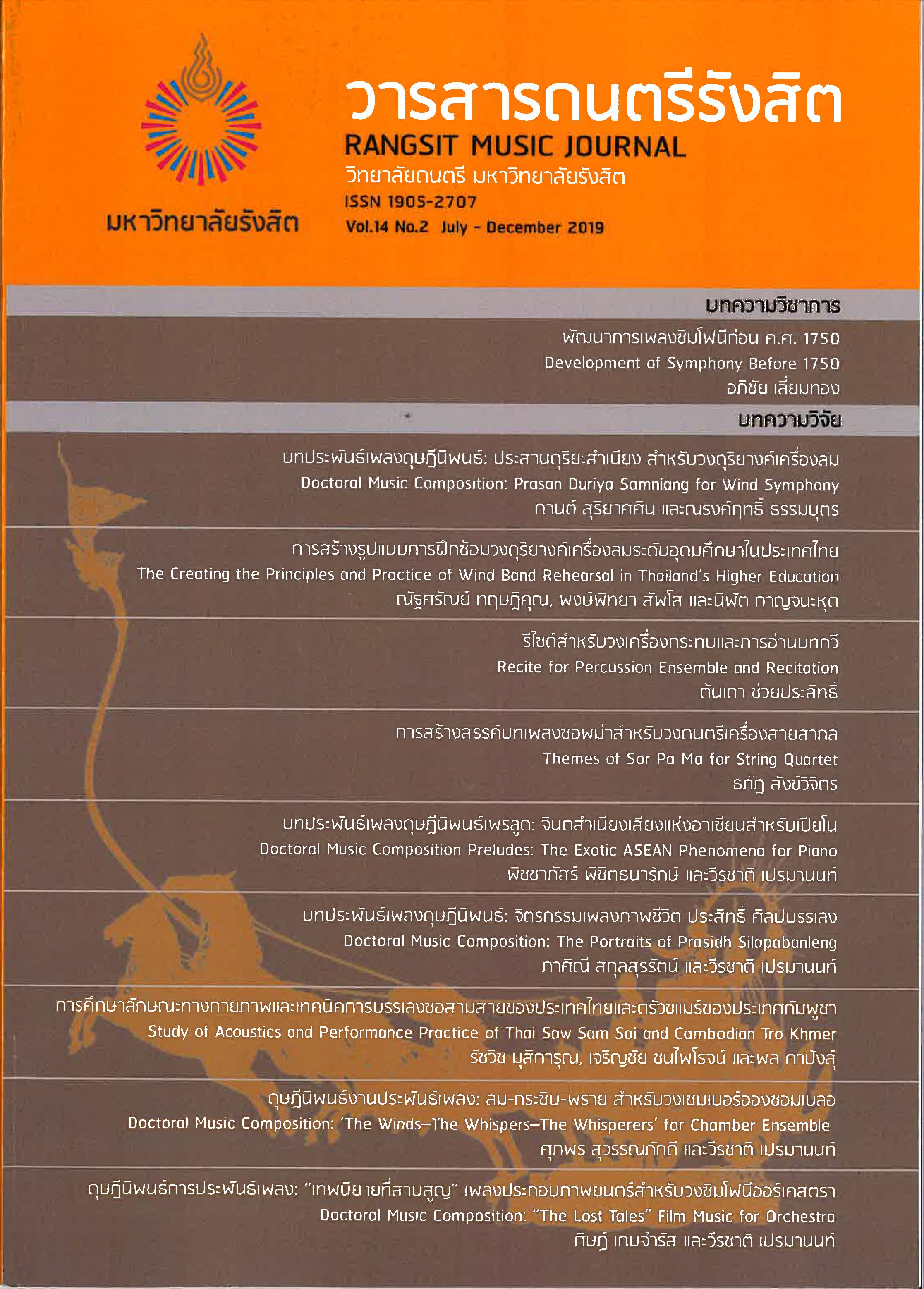Doctoral Music Composition: The Portraits of Prasidh Silapabanleng
Keywords:
The Portraits of Prasidh Silapabanleng, Pi, KotoAbstract
The Doctoral Music Composition “The Portraits of Prasidh Silapabanleng” is intended to create a contemporary piece that integrates the concept of Thai and Japanese music composition with the concept of western music composition and to convey impressive life story of Prasidh Silapabanleng (1912-1999), Thailand’s National Artist in Performing Arts (Composer), who possessed great capabilities in Thai traditional music and western music. This Doctoral Music Composition consists of three movements: Movement 1 “Wang Burabhabhirom” for Pi and Octet, portraying the character of Luang Pradit Phairoh who laid a strong foundation for Prasidh’s professional career; Movement 2 “Tokyo Ongaku Gakko” for Koto and String Quintet, portraying the life of Prasidh during his years of education in Japan; and Movement 3 “Ban Batt” for Pi Nai, Koto and Wind Symphony, portraying the career establishment of Prasidh after returning from Japan. Total duration of the Composition is approximately 35 minutes under Tone Center with the use of unique oriental scales, signifying characteristics of Thai and Japanese music. The work is a further development of contemporary music composition approach which delivers both aesthetic and academic value.
References
2. ณรงค์ฤทธิ์ ธรรมบุตร. อรรถาธิบายและบทวิเคราะห์บทเพลงที่ประพันธ์โดย ณรงค์ฤทธิ์ ธรรมบุตร. กรุงเทพฯ: ธนาเพลส, 2553.
3. ณัชชา พันธุ์เจริญ. พจนานุกรมศัพท์ดุริยางคศิลป์. พิมพ์ครั้งที่ 4. กรุงเทพฯ: เกศกะรัต, 2554.
4. ประสิทธิ์ ศิลปบรรเลง. อนุสรณ์พระราชทานเพลิงศพนายประสิทธิ์ ศิลปะบรรเลง. กรุงเทพฯ: วชิรินทร์สาส์น, 2542.
5. พูนพิศ อมาตยกุล. การก่อเกิดเพลงไทยสากล: แนวคิดด้านดนตรีวิทยา. กรุงเทพฯ: อมรินทร์พริ้นติ้งแอนด์พับลิชชิ่ง, 2554.
6. วิบูลย์ ตระกูลฮุ้น. "คอนแชร์โตสำหรับวงออร์เคสตรา (Concerto for Orchestra)." วารสารดนตรีรังสิต 11, 1 (2559): 33-45.
7. ศิริมงคล นาฏยกุล. ผกาวลี ตำนานละครเวทีของไทย. กรุงเทพฯ: อินทนิล. 2555.
8. อติภพ ภัทรเดชไพศาล. เสียงของศตวรรษ สังเขปแนวคิดและเทคนิคของ 10 นักแต่งเพลงสมัยใหม่. กรุงเทพฯ: ภาพพิมพ์, 2560.
9. อานันท์ นาคคง, อัษฎาวุธ สาคริก, และสุจิตต์ วงษ์เทศ. หลวงประดิษฐไพเราะ (ศร ศิลปบรรเลง) มหาดุริยกวีลุ่มเจ้าพระยาแห่งอุษาคเนย์. พิมพ์ครั้งที่ 3. กรุงเทพฯ: สำนักพิมพ์มติชน, 2547.
10. Adler, Samuel. The Study of Orchestration. New York: W.W. Norton & Company, 2002.
11. Miyagi & Yamakawa. Sugu Yakunitatsu Hogaku no Gakuri to Jitsai. Tokyo: Hogaku Sha, 2002.
12. Ohara, Inuma and others. Chugakusei no Gakki. Tokyo: Kyoiku-Geijutsu Sha, 2016.
13. Sorell, N. “A study of unique artist and his music: Prasidh Silpabanleng, (1912-1999).” SPAFA Journal 10, 1 (2000), 5-24.
14. Yokoi & Sakai. Nihon and Asia no Dento Ongaku. Tokyo: Meiji Tosho, 2014.







